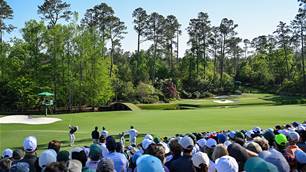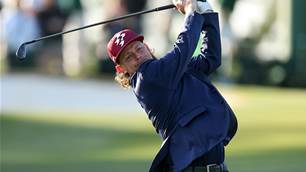I want it to be Rory. Chances are you want it to be Rory. And the editor of this crackerjack journal would like it to be Rory, given he’s splashed the man all over the cover and throughout the pages of our glossy bit of kit which is still a bargain at $9.08 per month at all respected subscription services.
But know this: there is nobody – nobody - who wants it to be Rory more than one man.
Rory.
And why, apart from those howling baboons on his back, not? A few reasons, which we’ll document in good time. For now, the positives.
At the age of 34, Rory McIlroy is prime. He is in his Caesar salad years. Physically, mentally, he is an elite-level, tip-top, professional buck athlete. Where “old” fellows such as 48-year-old Fred Funk (2005 Players Champion) and 50-year-old Phil Mickelson (2021 USPGA champion) can sneak off with the pie on occasion, more often it’s golf’s hot actor, the one aged roughly 27 to 40, thereabouts, who possesses the length, strength, athleticism, flexibility, and game-, course- and self-management to win the great tournaments of our time.
But you need even more to win a major. At the very pointy end, it’s about channelling one’s emotional juices into a smooth and powerful physicality that gets it done. It’s using one’s lived experience. It’s rising to meet the occasion. It is the opposite of choking.
Consider Stuart Appleby. He wasn’t a choker; he won nine times on the PGA Tour. I once had lunch with him; it would have been 2006, and he was a world top-20 player who’d known a top rank of 8th. He’d shot 59 at the Greenbrier. He’d run T2 in the Open Championship after a four-man playoff. He led the 2007 Masters after three rounds. He won the Australian Open and was always mentioned in dispatches around the majors. He was one of Them; a big, inside-the-ropes, swinging dick, to coin a phrase.

And he said something at lunch that’s always stuck with me. He said he could not hit 5-iron any better. There was no way he could hit 5-iron, or any of his irons, better than the way he did, because nobody could. Like, in the world. Yes, he was an elite player. But there were a hundred guys like him who could stand on a flat range and hit a hundred balls in a row within 20 feet. I’m paraphrasing, slightly. But that’s the gist of it.
Similarly, I once stood behind Aaron Baddeley on the range at The Australian and watched him hit 5-irons; the ball fading, time after time, through the same plane, roughly halfway between the 175m and 200m markers. Bang, bang, bang, time after time. Pure. Man, it was cool.
Where Baddeley, Appleby, and so many like them didn’t take the next step to major greatness – lookin’ at you, too, KJ Choi – was emotionally. They couldn’t ride the lightning, couldn’t channel it. While Tiger Woods was out uppercutting imaginary short people with so many celebratory fists, Appleby’s muse was Retief Goosen, a mild-mannered man just north of mute.
Yes, Goosen won two majors with his blend of dead-eyed swinging-dickness. But Appleby, Baddeley and KJ, and let’s throw in Nick O’Hern, just played. Their thing was: pre-shot routine; swing the club; watch result; walk on; repeat. Shot after shot, round after round.
McIlroy is, of course, in the super-elite category. You put him on the range with a mid-iron much less a wedge, he’ll hit a hundred in a row within 20-feet. And you’ll stand on the range and gape as I did behind Badds.

But, so what, right? To win a major championship, you need to channel the juices and enter a sort of crazy-fugue state, one that Scottie Scheffler gets himself in, that Dustin Johnson and Brooks Koepka have done, that Xander Schauffele rode on the wind to glory at Royal Troon. It’s when there’s not a whole lot going on in your head outside of trying to subjugate an entire field of golfers who cannot hit 5-iron any better.
McIlroy knows this state. The man’s won four majors and the Players, and more money than the Republic of Burundi. But, at Augusta, he’s not been able to marry his preternatural ability to play the game with the right mix of madness and self-management.
Now, not to get all amateur Sigmund Freud here, but the eyes, to paraphrase Tony Montana (Al Pacino), in Scarface (1980) are the window to the soul. And to look into McIlroy’s eyes with four holes to play after he’s chopped his way out of contention in another major title, is to see a deflated man.
Look into those eyes of his when Bryson DeChambeau made that marvellous, ridiculous sand-save on 72 at Pinehurst No.2. You think that was a chap who wanted to have a chat post-round? Our Rors took right off. And it wasn’t for a lack of respect for DeChambeau, as was mooted. It was because of utter loss. It was like grief, bereavement. And media who’d choke in the Monthly Medal declared he should take it like a man, and not “dishonour” the champion.
They do have a point. But walk in the man’s shoes. He’d missed a three-footer on 15. He’d missed a three-footer on 18. He’d bogied three of the last four. And it was all there, in his eyes, outside the scorer’s office. Hollowness. Even sickness. Nothing good, nothing positive, anyway. Get me out of here.
Yet it’s that very emotion, channelled into laser-focused resolve, with a lacing of “mongrel” and his justified and ever-ready belief in Rory McIlroy – and a golf game that, on its day, can beat anyone on this mother Earth – that Rory McIlroy can ride again at Augusta National at this 89th annual Masters tournament.
Because this: he’s been close before, he’ll be close again. And, this year, in form, winning a recent habit (in The Players, mind), he’s all but put his arms upwards and backwards like a baby bird, ready for Scheffler to drape the green jacket over him.
He may need a few hours on Dr Bob Rotella’s couch before then, however.
Related Articles

Hits and memories of Rory at Augusta

Rory the winner, but Augusta the undefeated champion of the 89th Masters












